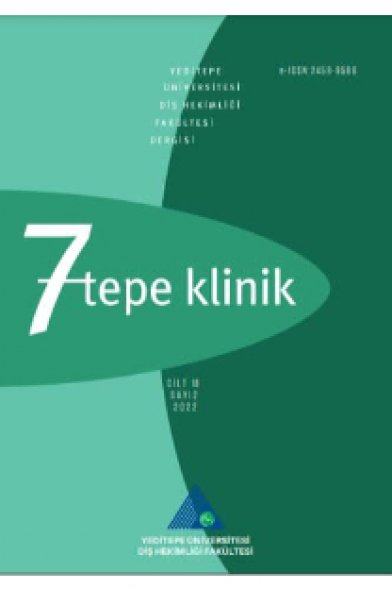Effectiveness of Two Apex Locators to Determine Simulated Horizontal Root Fractures
Farklı Seviyelerde Yapay Olarak Oluşturulmuş Horizontal Kök Kırıklarının Tespitinde İki Apeks Bulucunun Doğruluğunun Karşılaştırılması
___
Topuz O, Uzun O, Tinaz AC, Bodrumlu E, Gorgul G. Accuracy of two apex-locating handpieces in detecting simulated vertical and horizontal root fractures. J Endod 2008; 34: 310-313.Lindhal B. Transverse intraalveolar root fractures: roentgen diagnosis and prognosis. Odont Revy 1958; 9: 10-24.
Goldberg F, Frajlich S, Kuttler S, Manzur E, Briseno-Marroquin B. The evaluation of four electronic apex locators in teeth with simulated horizontal oblique root fractures. J Endod 2008; 34: 1497-1499.
Pallares A, Faus V. An in vivo comparative study of two apex locators. J Endod 1994; 20: 576-579.
Fuss Z, Assooline LS, Kaufman AY. Determination of location of root perforations by electronic apex locators. Oral Surg Oral Med Oral Pathol Oral Radiol Endod 1996; 82: 324-329.
Gordon MP, Chandler NP. Electronic apex locators. Int Endod J 2004; 37: 425-437.
Suzuki K. Experimental study on iontophoresis. J Jpn Stomatol 1942; 16: 411-429. 8.Sunada I. New method for measuring the lenght of the root canal. J Dent Res 1962; 41: 375-387.
Ebrahim AK, Wadachi R, Suda H. Accuracy of three different electronic apex locators in detecting simulated horizontal and vertical root fractures. Aust Endod J 2006; 32: 64-69.
Nahmias Y, Aurelio JA, Gerstein H. Expanded use of the electronic canal length measuring devices. J Endod 1983; 9: 347-349.
Cimilli H, Aydemir S, Arican B, Mumcu G, Chandler N, Kartal N. Accuracy of the Dentaport ZX apex locator for working length determination when retreating molar root canals. Aust Endod J 2014; 40: 2-5.
Kustarci A, Arslan D, Altunbas D. In vitro comparison of working length determination using three different electronic apex locators. Dent Res J 2014; 11: 568-573.
Pascon EA, Marrelli M, Congi O, Ciancio R, Miceli F, Versiani MA. An in vivo comparison of working length determination of two frequency-based electronic apex locators. Int Endod J 2009; 42: 1026-1031.
Altunbas D, Kustarci A, Toyoglu M. The Influence of Various Irrigants on the Accuracy of 2 Electronic Apex Locators in Locating Simulated Root Perforations. J Endod 2017; 43: 439-442
Altunbas D, Kustarci A, Arslan D, Er K, Kocak S. Comparison of various current electronic apex locators to determine the working length using the clearing technique. Niger J Clin Pract 2015; 18: 359-363.
Cvek M, Mejare I, Andreasen JO. Conservative endodontic treatment of teeth fractured in the middle or apical part of the root. Dent Traumatol 2004; 20: 261-269.
Baldi JV, Victorino FR, Bernardes RA, de Moraes IG, Bramante CM, Garcia RB, et al. Influence of embedding media on the assessment of electronic apex locators. J Endod 2007; 33: 476-479.
Czerw RJ, Fulkerson MS, Donnelly JC. An in vitro test of a simplified model to demonstrate the operation of electronic root canal measuring devices. J Endod 1994; 20: 605-606. 19.Ushiyama J. New principle and method for measuring the root canal length. J Endod 1983; 9: 97-104.
Azabal M, Garcia-Otero D, de la Macorra JC. Accuracy of the Justy II Apex locator in determining working length in simulated horizontal and vertical fractures. Int Endod J 2004; 37: 174-177.
al Kadi H, Sykes LM, Vally Z. Accuracy of the Raypex-4 and Propex apex locators in detecting horizontal and vertical root fractures: an in vitro study. SADJ 2006; 61: 244- 247.
D'Assuncao FL, Sousa JC, Felinto KC, de Medeiros TC, Leite DT, de Lucena RB, et al. Accuracy and repeatability of 3 apex locators in locating root canal perforations: an ex vivo study. J Endod 2014; 40: 1241-1244.
Shin HS, Yang WK, Kim MR, Ko HJ, Cho KM, Park SH, et al. Accuracy of Root ZX in teeth with simulated root per -foration in the presence of gel or liquid type endodontic irrigant. Restor Dent Endod 2012; 37: 149-154.
Herrera M, Abalos C, Lucena C, Jimenez-Planas A, Lla -mas R. Critical diameter of apical foramen and of file size using the Root ZX apex locator: an in vitro study. J Endod 2011; 37: 1306-1309.
Lee SJ, Nam KC, Kim DW. Clinical accuracy of a new apex locator with an automatic compensation circuit. J Endod 2002; 28 706-709.
- ISSN: 2458-9586
- Yayın Aralığı: 3
- Başlangıç: 2005
- Yayıncı: Yeditepe Üniversitesi Rektörlüğü
Monolitik Zirkonya - Rezin Siman Bağlantısına Farklı Yüzey İşlemlerinin Etkisi
İPEK ÇAĞLAR, SABİT MELİH ATEŞ, Fatih Mehmet KORKMAZ, ZEYNEP YEŞİL DUYMUŞ
Effectiveness of Two Apex Locators to Determine Simulated Horizontal Root Fractures
DİLARA ARSLAN, DEMET ALTUNBAŞ, Alper KUŞTARCI
Dudak-damak yarıklı bireylerde görülen doğumsal ve gelişimsel problemler
NİLÜFER İREM TUNÇER, Alev YILMAZ
Supernumere dişler ne sıklıkta görülürler? Retrospektif radyografik pilot çalışma
FATİH CABBAR, M. Çağrı BURDURLU, Çınar KULLE, Berk TOLONAY, Akanay ÇOPUROĞLU, Ata Mert YASA, R. Ceren BEKER, Özge ŞEN, Emre KALAYCIOĞLU, Can KARAKURT, Süeda DOĞRUSÖZ, Büşra KARA, Narod ALCAN
Premolar çekimli ve çekimsiz tedavinin yüz yumuşak dokuları üzerine etkilerinin incelenmesi
Metaphorical perceptions of dental students towards pediatric dentistry clinic
BURAK BULDUR, Çiğdem ÇUKURCU, Özge Nur GÜVENDİ, Mevlut KAYABASI, MERVE NUR AYDIN
ZELİHA GONCA BEK KÜRKLÜ, Mehmet Emin TÜRKÖZ
MAKBULE HEVAL ŞAHAN, Tuğrul SAYGI, Engin ARAS, TOMURCUK ÖVÜL KÜMBÜLOĞLU
Berkem ATALAY, Mohammed Ghazı Allan SALAHALDIN
Zeynep Aslı GÜÇLÜ, Zekiye HİDAYET, DİLEK GÜNAY CANPOLAT, FATMA DOĞRUEL
